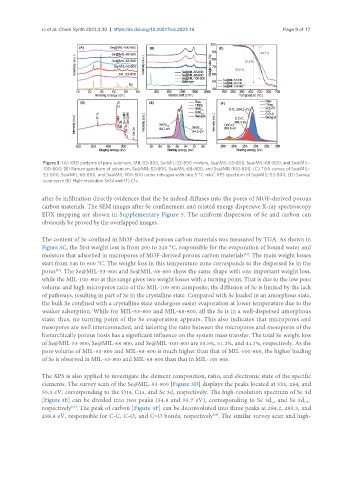Page 57 - Read Online
P. 57
Li et al. Chem Synth 2023;3:30 https://dx.doi.org/10.20517/cs.2023.16 Page 9 of 17
Figure 3. (A) XRD patterns of pure selenium, MIL-53-800, Se-MIL-53-800 mixture, Se@MIL-53-800, Se@MIL-68-800, and Se@MIL-
100-800; (B) Raman spectrum of selenium, Se@MIL-53-800, Se@MIL-68-800, and Se@MIL-100-800; (C) TGA curves of Se@MIL-
-1
53-800, Se@MIL-68-800, and Se@MIL-100-800 under nitrogen with rate 5 °C min . XPS spectrum of Se@MIL-53-800; (D) Survey
scan curve (E) High-resolution Se3d and (F) C1s.
after Se infiltration directly evidences that the Se indeed diffuses into the pores of MOF-derived porous
carbon materials. The SEM images after Se confinement and related energy dispersive X-ray spectroscopy
EDX mapping are shown in Supplementary Figure 5. The uniform dispersion of Se and carbon can
obviously be proved by the overlapped images.
The content of Se confined in MOF-derived porous carbon materials was measured by TGA. As shown in
Figure 3C, the first weight loss is from 200 to 240 °C, responsible for the evaporation of bound water and
moisture that adsorbed in micropores of MOF-derived porous carbon materials . The main weight losses
[61]
start from 340 to 600 °C. The weight loss in this temperature zone corresponds to the dispersed Se in the
[62]
pores . The Se@MIL-53-800 and Se@MIL-68-800 show the same shape with one important weight loss,
while the MIL-100-800 at this range gives two weight losses with a turning point. That is due to the low pore
volume and high micropores ratio of the MIL-100-800 composite; the diffusion of Se is limited by the lack
of pathways, resulting in part of Se in the crystalline state. Compared with Se loaded in an amorphous state,
the bulk Se confined with a crystalline state undergoes easier evaporation at lower temperature due to the
weaker adsorption. While for MIL-53-800 and MIL-68-800, all the Se is in a well-dispersed amorphous
state; thus, no turning point of the Se evaporation appears. This also indicates that micropores and
mesopores are well interconnected, and tailoring the ratio between the micropores and mesopores of the
hierarchically porous hosts has a significant influence on the system mass transfer. The total Se weight loss
of Se@MIL-53-800, Se@MIL-68-800, and Se@MIL-100-800 are 53.5%, 51.2%, and 44.7%, respectively. As the
pore volume of MIL-53-800 and MIL-68-800 is much higher than that of MIL-100-800, the higher loading
of Se is observed in MIL-53-800 and MIL-68-800 than that in MIL-100-800.
The XPS is also applied to investigate the element composition, ratio, and electronic state of the specific
elements. The survey scan of the Se@MIL-53-800 [Figure 3D] displays the peaks located at 533, 284, and
55.3 eV, corresponding to the O1s, C1s, and Se 3d, respectively. The high-resolution spectrum of Se 3d
[Figure 3E] can be divided into two peaks (54.8 and 55.7 eV), corresponding to Se 3d and Se 3d ,
5/2
3/2
respectively . The peak of carbon [Figure 3F] can be deconvoluted into three peaks at 284.2, 285.3, and
[63]
288.8 eV, responsible for C-C, C-O, and C=O bonds, respectively . The similar survey scan and high-
[64]

